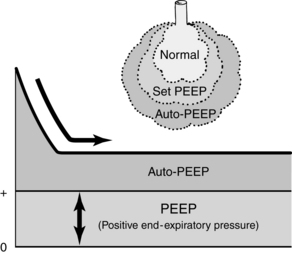Auto–Positive End-Expiratory Pressure (Auto-PEEP) Calculation
PREREQUISITE NURSING KNOWLEDGE
• Auto–positive end-expiratory pressure (Auto-PEEP) is often called occult because it is not set on the ventilator; instead, it is a result of inadequate exhalation time (Fig. 30-1).2–11
• Auto-PEEP is associated with high minute ventilation requirements, small-diameter endotracheal tubes, bronchospasm, long inspiratory times, high respiratory rates, and mechanical factors, such as water accumulation in the ventilator tubing.2–11
• Auto-PEEP may result in an increased work of breathing. The set sensitivity of the ventilator is referenced to the amount of set-PEEP selected by the clinician. Because auto-PEEP is not sensed by the ventilator, the patient has to generate a pressure equal to the set sensitivity plus auto-PEEP to “trigger” inspiratory flow or a breath from the ventilator.2,9
• Auto-PEEP may elevate static pressure (i.e., plateau pressure). High plateau pressures can result in barotrauma and hemodynamic compromise.9
• Auto-PEEP may be a desirable outcome of select ventilator settings (e.g., pressure-controlled inverse ratio ventilation). In these cases, the goal of auto-PEEP is to restore functional residual capacity and reduce shunt.
• Interventions to offset auto-PEEP include the use of large-diameter endotracheal tubes, bronchodilators, short inspiratory times, long expiratory times, lower respiratory rates, frequent emptying of ventilator circuit water accumulation (heated circuits may eliminate this complication), and the use of sedatives and narcotics (if the patient’s breathing pattern is such that it increases the minute ventilation). Occasionally the addition of set-PEEP is used to offset auto-PEEP. The addition of set-PEEP serves as a splint by keeping the airway open throughout exhalation, decreasing auto-PEEP.2–7,11 An example of this technique is the patient with chronic obstructive pulmonary disease in whom early airway closure during exhalation results in gas trapping.


